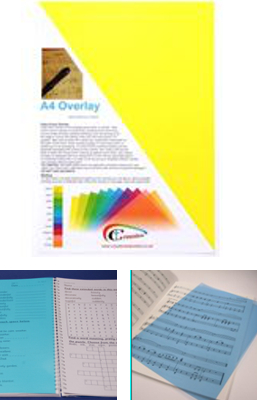A4 Yellow Overlay
 |
A4 overlays can be preferable to the smaller, Reading
Rulers in a number of cases. In addition, it may be
preferable when reading pages of music, factual information
sheets etc. to be able to see the whole page. Overlays can
easily be cut in half to use with smaller pages.
|
Visual Stress/ Eye Strain
Visual Stress can cause headaches, migraines, reading discomfort and
distortion of text that can vary from mild to so severe that
reading is seriously impaired or even prevented. Many people would benefit from the
use of a coloured overlay at these times.
'Visual Stress' can be experienced by
anyone, not particularly people with dyslexia, which is a
totally separate and distinct neurological condition.
The effects of Visual Stress can often be easily and
inexpensively remedied by the use of coloured overlays. The
overlays can also help children and adults who have to do a lot of
reading, particularly if this is black ink on white paper or
during the evening, for example, when their eyes are tired.
For many people the overlays can also make reading a far more pleasurable
experience and eliminate headaches and migraines.
*Please note the colour shown in the picture may not be an
exact representation of the colour in real life.
By experimenting with different combinations it is usually
possible to meet individual needs, although there may be a
small number of individuals who would benefit from a tint that
cannot be produced.
*Please note the colours shown in the picture may not be an
exact representation of the colour in real life and can only be
used as an estimate.
The Difference an Overlay can make:
As part of my learning assessment I test the use of coloured
overlays with my clients. I always ask whether each colour in
turn makes the print easier to see, harder to see or makes no
difference when compared with words written in black ink on a
white background:
One little boy of eight said that none of the
overlays made any difference until we tried the green. He
immediately did a double take and ran to show his mum. He said,
‘Look mum, without the green all of the words stick together,
but with the green there are gaps!” And all this time he had
had to work out when one word ended and the next began!
One woman was amazed when we tried the pink
overlay as without it the lines of text moved up and down, with
the overlay they stayed still and the difference in her ability
to read the page of text was significant.
These incidences are more extreme and uncommon. For many of us, an overlay can simply reduce or soften the glare of black ink on a white background and make it easier to access the text.
Additional Information:
The British Dyslexia Association have reported that around 35-40% of
people with dyslexic difficulties are estimated to experience
visual disturbance or discomfort when reading print.
These children and adults may experience one or several of the
following:
- Blurred/fuzzy letters or words which go out of focus.
- Letters which move, shimmer, whirl or move off the pager or present with back to front appearance.
- Headaches or migraines as a result of reading.
- Find whiteboards difficult to read or copy from
- Constantly rub or blink their eyes to help bring the print back into focus
- Find it easier to read large, widely spaced print, than small and crowded.
- Difficulty with tracking across the page, omitting words or lines of text.
- Upset by glare on the page or oversensitive to bright lights. Students in school or adults in offices will find fluorescent lights particularly difficult.
All of this makes reading a difficult activity.
Unfortunately, children and indeed sometimes adults don’t tell
us that they are experiencing these difficulties as they think
it is the same for everyone.
This condition may be due to a visual-perceptual disorder
or simply Visual Stress. In many cases, this particular
condition can be remedied by a very simple and inexpensive
intervention: reading through a coloured overlay that changes
the colour of the page.
References
2.
3. Jeanes, R., Busby, A., Martin, J., Lewis, E., Stevenson, N., Pointon, D., and
Wilkins A.J. (1997). Prolonged use of coloured overlays for classroom reading.
British Journal of Psychology, 88, 531-548.